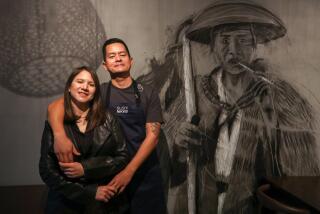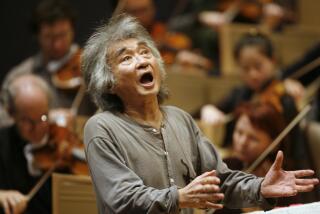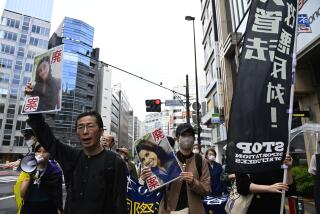THE Pacific : LOOKING WEST FOR AN MBA : Japan, Whose Management Techniques Have Long Been Touted, Enlists Dartmouth Professors to Teach Business Program
Most of the managers who have piloted East Asia’s industrialization since World War II learned the art of management on the job, at company training courses or within the family. But now applications and enrollments at U.S.-inspired graduate business schools in East Asia are rising. Japanese corporations, which have particularly relied on in-house training, are starting to put more of their middle-level managers through master of business administration programs.
And this fall, U.S. management thinking may become even more influential when Dartmouth University’s Amos Tuck School of Business Administration launches a two-year MBA program at the International University of Japan.
The demand for highly quantitative business education stems from Japanese corporations’ growing need for international executives to run their overseas operations, said Colin C. Blaydon, Tuck’s dean. American models are increasingly applicable to Japan as its markets become more open and competitive, he said. “A number of them see the changes that are going on in Japan and feel they have something to learn.”
East Asia’s new demand for MBAs comes from the local subsidiaries of Western corporations, from publicly held corporations and, increasingly, from large family-run businesses that previously groomed their own managers for top jobs, said Robert Tricker, a professor of finance and accounting at Hong Kong University. “I think they recognize the experience their people have had, good as it has been . . . is not enough,” he said in a telephone interview.
Some Diploma Mills
Across much of East Asia, interest in obtaining an MBA has leaped just in the past five years, Tricker said. Hong Kong University now receives 10 applications for each spot in its 40-student part-time MBA program. USC’s International Business Education and Research program, a 12-month MBA curriculum geared to Pacific Rim studies, has seen the number of applicants from Taiwan double in the past two years and the number of Japanese applicants double since last year, associate director Jack G. Lewis said.
Such is the demand in Hong Kong for an MBA that confidence men do a brisk business in fake diplomas based on little or no course work, Tricker said. “Too many charlatans are coming in selling diplomas to people who are gullible.”
Buyers are disappointed to find that such a diploma may have little credibility with employers, he said, and “isn’t worth the paper it’s printed on.” The shortage of slots at top-notch business schools may help Tuck’s new program, he added.
Taught by IUJ professors together with U.S. professors from Tuck’s campus in Hanover, N.H., the curriculum will be only the second graduate program for business studies in Japan, and the first with all instruction in English, Blaydon said. The first class will have about 50 students, roughly 35 of them Japanese managers sponsored by their corporations.
The only Japanese university now offering an MBA program is Tokyo’s 130-year-old Keio University. Keio’s Graduate School of Business Administration in Yokohama graduates 30 to 40 MBAs a year, compared to nearly 60,000 graduates annually in the United States, said Paul A. Argenti, an adjunct professor of communications at Tuck. Harvard Business School has maintained a loose affiliation with Keio’s program, training many of its scholars and sending its professors to Japan as well.
Tuck Controls Curriculum
Graduate business education became popular in the United States after World War II as preparation for corporate leadership, spread to Europe in the 1970s and now is gaining adherents in East Asia as well.
Founded six years ago by 850 Japanese businesses and associations that contributed $80 million, the International University of Japan will provide a good base for Tuck professors seeking to develop case studies of Japanese corporations, Argenti said. IUJ will pay all the professors’ salaries, but Tuck will retain control over the curriculum, he said. “How can you miss?”
Tuck is not worried that such an arrangement will constrain academic freedom, Blaydon said. U.S. business schools rely heavily on corporate donations, he pointed out. Any attempt by an IUJ sponsoring Japanese corporation to arrange the removal of a professor who wrote a hostile case study, he said, “would be a very serious conflict that would require a full reevaluation of the relationship.”
Argenti said that although none of the Tuck professors speak Japanese, he was not worried about their ability to research case studies. “We have interpreters who will be working with us full time. . . . I think these interpreters should be darn good,” he said, adding that he would take an intensive course in the language this summer. Dartmouth does not offer Japanese, although it plans to add the language soon, Blaydon said.
The lack of Japanese-speaking professors may help the Tuck program compete with U.S. business schools, USC’s Lewis said. Japanese personnel directors are less interested in training their managers in quantitative business analysis than in giving them fluent English and a solid grounding in international business practices, he said. “Training managers in Japan feel they have to get their managers to the United States or to Europe.”
Many New Experiences
Argenti acknowledged that given the current poor repute of American management techniques, exporting them to much admiredJapan was an incongruous move. “Everybody says, you know, why would they want this. They have so few lawyers and now maybe they’ll start a law school,” as well, he said. (Japan already has several law schools, but the entire country has only one-third as many practicing lawyers as Los Angeles County alone.)
Teaching in Japan will present Tuck professors with a range of new cultural and living experiences, Argenti said. A specialist in corporate communications, graphics and “logos and things like that,” Argenti is fascinated by his shiny new Japanese calling cards. They bear his name, title and institution in English on one side and in Japanese on the reverse. With more than 3,000 characters in the written Japanese language of Kanji, he said, “it’s a nightmare to think about printing typefaces in Japan.”
Argenti’s middle initial was left in English on the Japanese side of the card to keep him from handing it over upside down, he said. “It’s not that the ‘A’ is untranslatable.”
The IUJ campus is in Urasa, a small town in the mountains of Niigata Prefecture next to the Sea of Japan, a 90-minute train ride to the northeast from Tokyo. The town gets up to eight feet of snow a year and has a climate that Blaydon said was milder than New Hampshire’s but which USC’s Lewis compared to Siberia. Asked whether he would be taking his skis, Argenti replied: “Oh absolutely. It’s a big, wonderful ski area. . . . Lots of powder.”
But the notorious high rents and scarcity of large living quarters in Japan have much less appeal for the professor.
“I live in a home here that’s about 3,000 square feet. I’ll be living there in an apartment that is 700 square feet,” said Argenti, who will arrive in Japan next March with his wife, a 3-year-old toddler and a baby expected late this summer. “We decided one thing we could do is move everything into our living room, to practice.”
More to Read
Sign up for Essential California
The most important California stories and recommendations in your inbox every morning.
You may occasionally receive promotional content from the Los Angeles Times.










